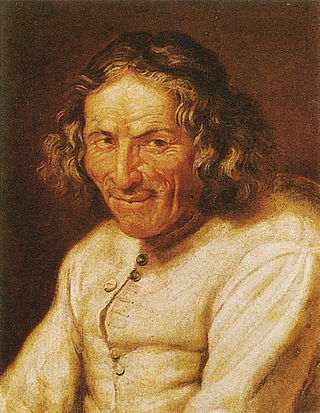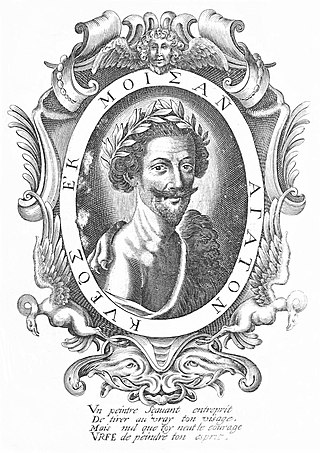Related Research Articles
High fantasy, or epic fantasy, is a subgenre of fantasy defined by the epic nature of its setting or by the epic stature of its characters, themes, or plot. High fantasy is set in an alternative, fictional ("secondary") world, rather than the "real" or "primary" world. This secondary world is usually internally consistent, but its rules differ from those of the primary world. By contrast, low fantasy is characterized by being set on Earth, the primary or real world, or a rational and familiar fictional world with the inclusion of magical elements.

Paul Scarron was a French poet, dramatist, and novelist, born in Paris. Though his precise birth date is unknown, he was baptized on 4 July 1610. Scarron was the first husband of Françoise d'Aubigné, who later became Madame de Maintenon and secretly married King Louis XIV of France.

Antoine Furetière was a French scholar, writer, and lexicographer, known best for his satirical novel Scarron's City Romance. He was expelled from the Académie Française for seeking to publish his own French language dictionary.

Madeleine de Scudéry, often known simply as Mademoiselle de Scudéry, was a French writer.

Georges de Scudéry, the elder brother of Madeleine de Scudéry, was a French novelist, dramatist and poet.
According to the medieval poet Jean Bodel, the Matter of Rome is the literary cycle of Greek and Roman mythology, together with episodes from the history of classical antiquity, focusing on military heroes like Alexander the Great and Julius Caesar. Bodel’s division of literary cycles also included the Matter of France and the Matter of Britain. The Matter of Rome includes the Matter of Troy, consisting of romances and other texts based on the Trojan War and its legacy, including the adventures of Aeneas.

Honoré d'Urfé, marquis de Valromey, comte de Châteauneuf was a French novelist and miscellaneous writer.
Fantastique is a French term for a literary and cinematic genre that overlaps with science fiction, horror, and fantasy.

Fantasy literature is literature set in an imaginary universe, often but not always without any locations, events, or people from the real world. Magic, the supernatural and magical creatures are common in many of these imaginary worlds. Fantasy literature may be directed at both children and adults.

As a literary genre, the chivalric romance is a type of prose and verse narrative that was popular in the noble courts of High Medieval and Early Modern Europe. They were fantastic stories about marvel-filled adventures, often of a chivalric knight-errant portrayed as having heroic qualities, who goes on a quest. It developed further from the epics as time went on; in particular, "the emphasis on love and courtly manners distinguishes it from the chanson de geste and other kinds of epic, in which masculine military heroism predominates."

Elements of the supernatural and the fantastic were an element of literature from its beginning. The modern genre is distinguished from tales and folklore which contain fantastic elements, first by the acknowledged fictitious nature of the work, and second by the naming of an author. Works in which the marvels were not necessarily believed, or only half-believed, such as the European romances of chivalry and the tales of the Arabian Nights, slowly evolved into works with such traits. Authors like George MacDonald (1824–1905) created the first explicitly fantastic works.

17th-century French literature was written throughout the Grand Siècle of France, spanning the reigns of Henry IV of France, the Regency of Marie de Medici, Louis XIII of France, the Regency of Anne of Austria and the reign of Louis XIV of France. The literature of this period is often equated with the Classicism of Louis XIV's long reign, during which France led Europe in political and cultural development; its authors expounded the classical ideals of order, clarity, proportion and good taste. In reality, 17th-century French literature encompasses far more than just the classicist masterpieces of Jean Racine and Madame de La Fayette.

Medieval French literature is, for the purpose of this article, Medieval literature written in Oïl languages during the period from the eleventh century to the end of the fifteenth century.
Antoine de Nervèze was a French nobleman and writer of novels, translations, letters and moral works at the end of the 16th and beginning of the 17th centuries.
English literature is literature written in the English language from the United Kingdom, its Crown Dependencies and Overseas Territories, the Republic of Ireland, the United States, and the countries of the former British Empire. The English language has developed over the course of more than 1,400 years. The earliest forms of English, a set of Anglo-Frisian dialects brought to Great Britain by Anglo-Saxon invaders in the fifth century, are called Old English. Beowulf is the most famous work in Old English, and has achieved national epic status in England, despite being set in Scandinavia. However, following the Norman conquest of England in 1066, the written form of the Anglo-Saxon language became less common. Under the influence of the new aristocracy, French became the standard language of courts, parliament, and polite society. The English spoken after the Normans came is known as Middle English. This form of English lasted until the 1470s, when the Chancery Standard, a London-based form of English, became widespread. Geoffrey Chaucer, author of The Canterbury Tales, was a significant figure in the development of the legitimacy of vernacular Middle English at a time when the dominant literary languages in England were still French and Latin. The invention of the printing press by Johannes Gutenberg in 1439 also helped to standardise the language, as did the King James Bible (1611), and the Great Vowel Shift.

A novel is a relatively long work of narrative fiction, typically written in prose and published as a book. The English word to describe such a work derives from the Italian: novella for "new", "news", or "short story of something new", itself from the Latin: novella, a singular noun use of the neuter plural of novellus, diminutive of novus, meaning "new". According to Margaret Doody, the novel has "a continuous and comprehensive history of about two thousand years", with its origins in the Ancient Greek and Roman novel, in Chivalric romance, and in the tradition of the Italian Renaissance novella. The ancient romance form was revived by Romanticism, in the historical romances of Walter Scott and the Gothic novel.

Romanticism was an artistic, literary, and intellectual movement that originated in Europe toward the end of the 18th century. Scholars regard the publishing of William Wordsworth's and Samuel Coleridge's Lyrical Ballads in 1798 as probably the beginning of the movement, and the crowning of Queen Victoria in 1837 as its end. Romanticism arrived in other parts of the English-speaking world later; in the United States, it arrived around 1820.

The Grottoes of Ferrand are a series of 17th-century artificial grottoes on the estate of the Château de Ferrand in Saint-Hippolyte, Gironde, in southwestern France, near the town of Saint-Émilion.
J. R. R. Tolkien's presentation of heroism in The Lord of the Rings is based on medieval tradition, but modifies it, as there is no single hero but a combination of heroes with contrasting attributes. Aragorn is the man born to be a hero, of a line of kings; he emerges from the wilds and is uniformly bold and restrained. Frodo is an unheroic, home-loving Hobbit who has heroism thrust upon him when he learns that the ring he has inherited from his cousin Bilbo is the One Ring that would enable the Dark Lord Sauron to dominate the whole of Middle-earth. His servant Sam sets out to take care of his beloved master, and rises through the privations of the quest to destroy the Ring to become heroic.

The type of romance considered here is mainly the genre of novel defined by the novelist Walter Scott as "a fictitious narrative in prose or verse; the interest of which turns upon marvellous and uncommon incidents", in contrast to mainstream novels which realistically depict the state of a society. These works frequently, but not exclusively, take the form of the historical novel. Scott's novels are also frequently described as historical romances, and Northrop Frye suggested "the general principle that most 'historical novels' are romances". Scott describes romance as a "kindred term", and many European languages do not distinguish between romance and novel: "a novel is le roman, der Roman, il romanzo".
References
- 1 2 Encyclopædia Britannica, Fifteenth Edition, Vol. 10. Encyclopædia Britannica, Inc., 1998.
- 1 2 3 4 One or more of the preceding sentences incorporates text from a publication now in the public domain : Gosse, Edmund (1911). "Heroic Romances". In Chisholm, Hugh (ed.). Encyclopædia Britannica . Vol. 13 (11th ed.). Cambridge University Press. pp. 384–385.
- ↑ "Letter 329". Tolkien Gateway. 2023-04-15. Retrieved 2023-07-27.